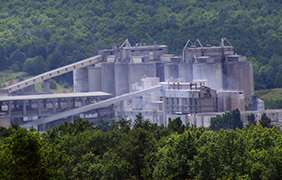Sonic Horns Application: Supplemental Rapping on European-Style ESPs
Many utility and industrial plants in the U.S. are still using European-style electrostatic precipitators (ESPs), most of which were built in the 1970s and 1980s before American-style ESPs (with external, magnetic impulse gravity impact rappers) came into vogue.
European-style ESPs, with internal, tumbling hammer rapping systems, are very robust and work well for applications involving high dust loadings and tenacious dust that’s difficult to dislodge from collecting plates. A tumbling hammer rapping system can easily run for 25-30 years with little or no significant repair.
But, eventually all that hammering wears out anvils, shafts, hammers, motor drives, weights, and pins. Many of these components are no longer being manufactured, so they have to be repaired or replaced with custom-made or used parts–if they can be found.
Retrofitting European-style ESPs with MIGIs or vibrators may be the long-term solution, but that’s a major undertaking requiring complete rebuild to separate and isolate plate bundles and wire frames.
Instead, or in the meantime, some plants are installing sonic horns for supplementary or replacement energy to clean. Successful use of horns in such cases depends on understanding the difference between rapping energy and sonic energy–and how each is best applied.
The main trick with sonic horns for cleaning ESP collection plates, says Jim Parsons, Senior Engineering Consultant at Neundorfer, is the application of knowing where not to put them.
“You never want to put sonic horns on the outlet field,” he stresses. “On a three-field precipitator, depending on the ash, I would even question putting them on the middle field.”
Placement is critical because energy from sonic horns has a different dynamic effect on collected ash than energy from rappers.
“Dust is held onto plates by the electrical field, and by particle cohesion,” Jim explains. “Rapping breaks the bond with the plate but allows particles to stay agglomerated, minimizing re-entrainment. Essentially, the dust sheers off in a big sheet and slides down into the hopper.”
Sounding a sonic horn has a very different effect.
“Energy from sonic horns breaks the cohesive bonds between particles,” Jim explains. “It does vibrate the dust off the plate, but a lot more of the particles break away and are re-entrained.”
Because of this dynamic, sonic horn energy is much different than typical rapping energy. But, in a bind, it offers a simple and economical alternative. Often, that’s the approach plants are taking when their European-style ESP hammers start to become unreliable and wear out.
For example, sonic horns were installed at a plant with a four-field, tumbling hammer ESP that treats a very high dust load from lignite coal. The inlet fields capture lots of duct, and when one of the rapping shafts breaks it causes a forced outage until repairs can be made. The plant simply added sonic horns on top of the inlet field so that if this occurs they can continue to run.
“In this case sonic horns are their backup,” Jim says. “If they lose a rapper, they can wait to come down until an off-peak period, and minimize lost revenue. They reported that the complete sonic horn installation paid for itself the first time it was needed!”
The biggest maintenance cost associated with sonic horns is compressed air, and Jim said this is often overestimated.
“Typically, sonic horns use 1 cubic foot per minute (CFM) of air at the operating pressure,” he explained. “If you sound the horn at 75 PSI, that’s 75 CFM. But horns are only sounded for a few seconds at a time–usually 5 seconds. So, really, you’re not using that much air.”
At some plants, horns have been added as the primary cleaning technology and are used daily either to replace tumbling hammers or to supplement inadequate rapping designs or when fuel changes have occurred.
“You can use sonic horns as the primary cleaning method, and take away all the tumbling hammers,” Jim acknowledges. “But, as you move closer to the outlet, be very cautious as the likelihood of re-entrainment increases.”
In a few cases, tumbling hammers on all fields have been taken out and replaced with sonic horns. This is only effective, however, on large ESPs with specific dust characteristics (high moisture content, large particle size and/or density, high moisture and/or very sticky), and if there is a scrubber or other system after the ESP to capture re-entrained ash.
Sonic horns have other applications, too–most notably as supplementary energy in baghouses and scrubbers, and to prevent side-wall buildup, rat-holing and bridging inside hoppers.
Sonic horns can help solve ESP cleaning issues–if applied correctly using sound engineering practices.
Helpful Resources
KnowledgeBase: Theory of Operations: Removal
KnowledgeBase: Reduce ReEntrainment
KnowledgeBase: Sonic Horns to Enhance RA & Shaker Cleaning
Our Capabilities: Process Analysis & Optimization



